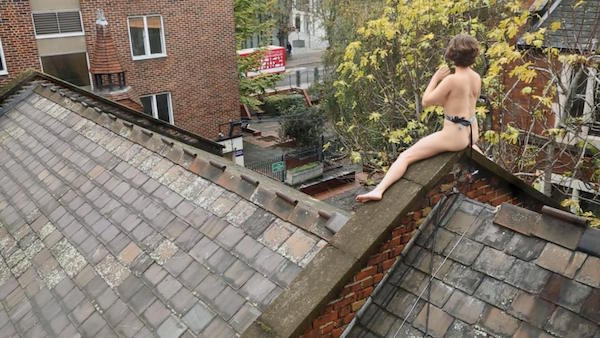Art World
Artist Who Sat Naked on London Rooftop Explains Why Nudity in Art Matters
The performance celebrates the power of the female body.

The performance celebrates the power of the female body.

Henri Neuendorf

Right now at #toynbeehall. What's happening? #nakedwomanonroof pic.twitter.com/dg0ydtAzi1
— Raquel Rodrigues (@raquelwatdahell) October 30, 2015
Last weekend, the sight of a woman perched naked on top of a London rooftop caused a great deal of confusion among locals and passers-by. The incident turned out to be a performance by artist Poppy Jackson, titled Site, and carried on for four hours.
Images of Jackson’s performance—which took place on the roof of Toynbee Studios in the city’s East End—went viral after an onlooker working in a nearby office shared photos of the unfolding of the bizarre event on social media. As proven time and time again (see Milo Moiré‘s numerous stunts, Switzerland’s naked performance art festival, and this Texas art student’s naked protest for just a few examples) nude performance art pretty much guarantees a headline.
After a mix of critical acclaim and bewildered reactions from Britain’s outspoken tabloids, the artist spoke to the Evening Standard about her performance.
Jackson admitted that she was “astounded by the global reach of the work,” and explained that the idea behind the performance was to “celebrate the power the body holds.”
Artist #PoppyJackson performance piece is "beautiful, disturbing & disruptive" https://t.co/htdg45e0Uk #artdex #art pic.twitter.com/3rcPPK3dtn
— ARTDEX (@theARTDEX) November 5, 2015
Addressing the media’s response to her work, she said “I think it has ‘confused’ people because I am celebrating my body in a way that is not sexually objectifying such as we are so accustomed to, whilst also critiquing why and how shame is layered upon the female body.”
“It’s obviously received some misogynistic responses because of the tabloids’ sensationalist take on the work,” she added, “but these comments just go to prove why artwork presenting the female body from a woman’s perspective is so important.”
“I think the reason that it has had an impact in the media is because this platform usually presents female bodies in a way that objectifies them or commodifies female sexuality,” Jackson argued.
Jackson emphasized that “Societal readings attributed to female sexuality […] is ‘for’ others. I use my body itself to work against this viewpoint, in a dignified and respectful way that celebrates the power the body holds.”
The artist also explained that she deliberately chose an outdoor venue for her performance to make the piece accessible to everyone.
“I believe that art is for everyone and that making work only for art galleries can, even accidentally, exclude many people, so I often make my work for public contexts, as it deals with themes that are political and social.”